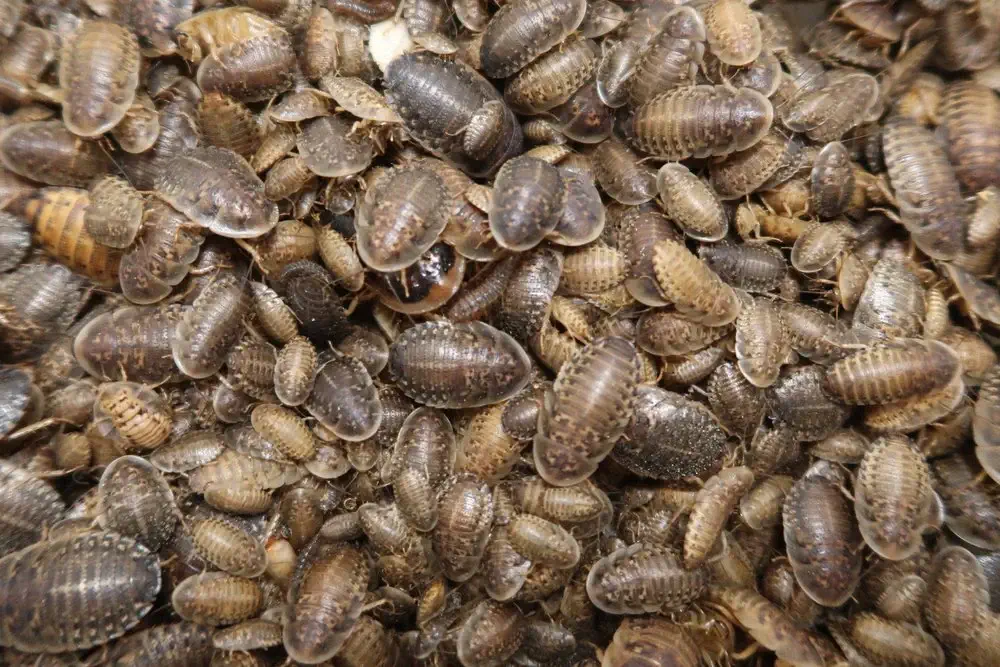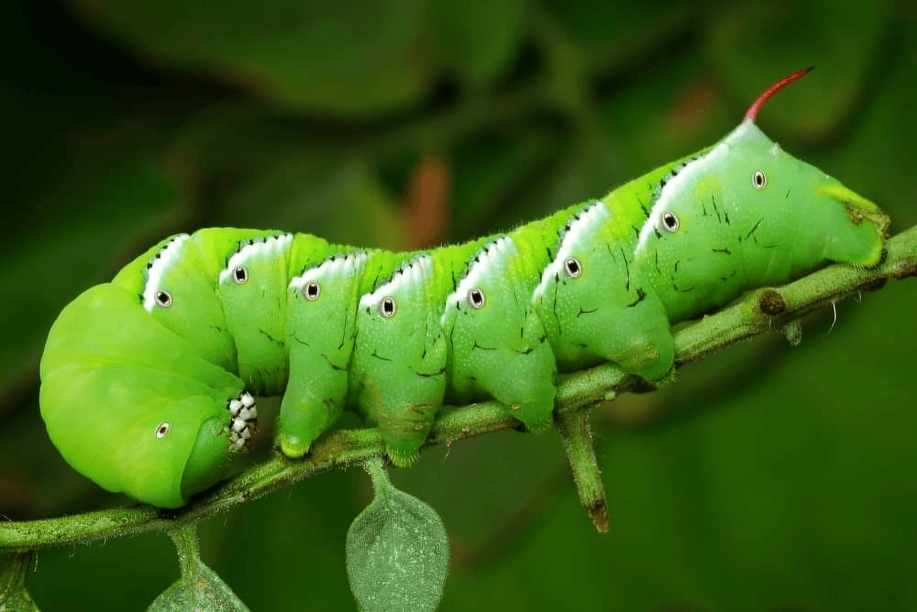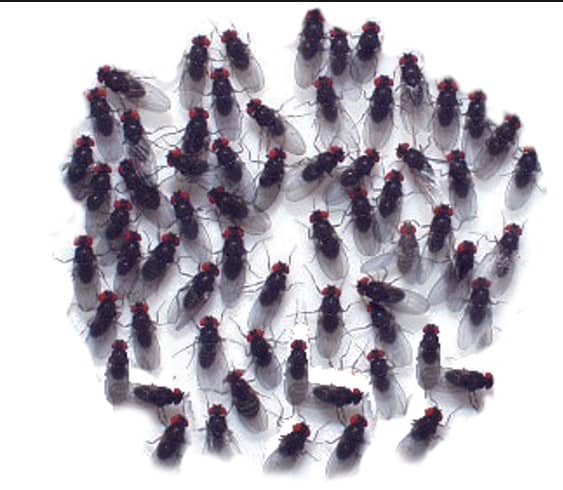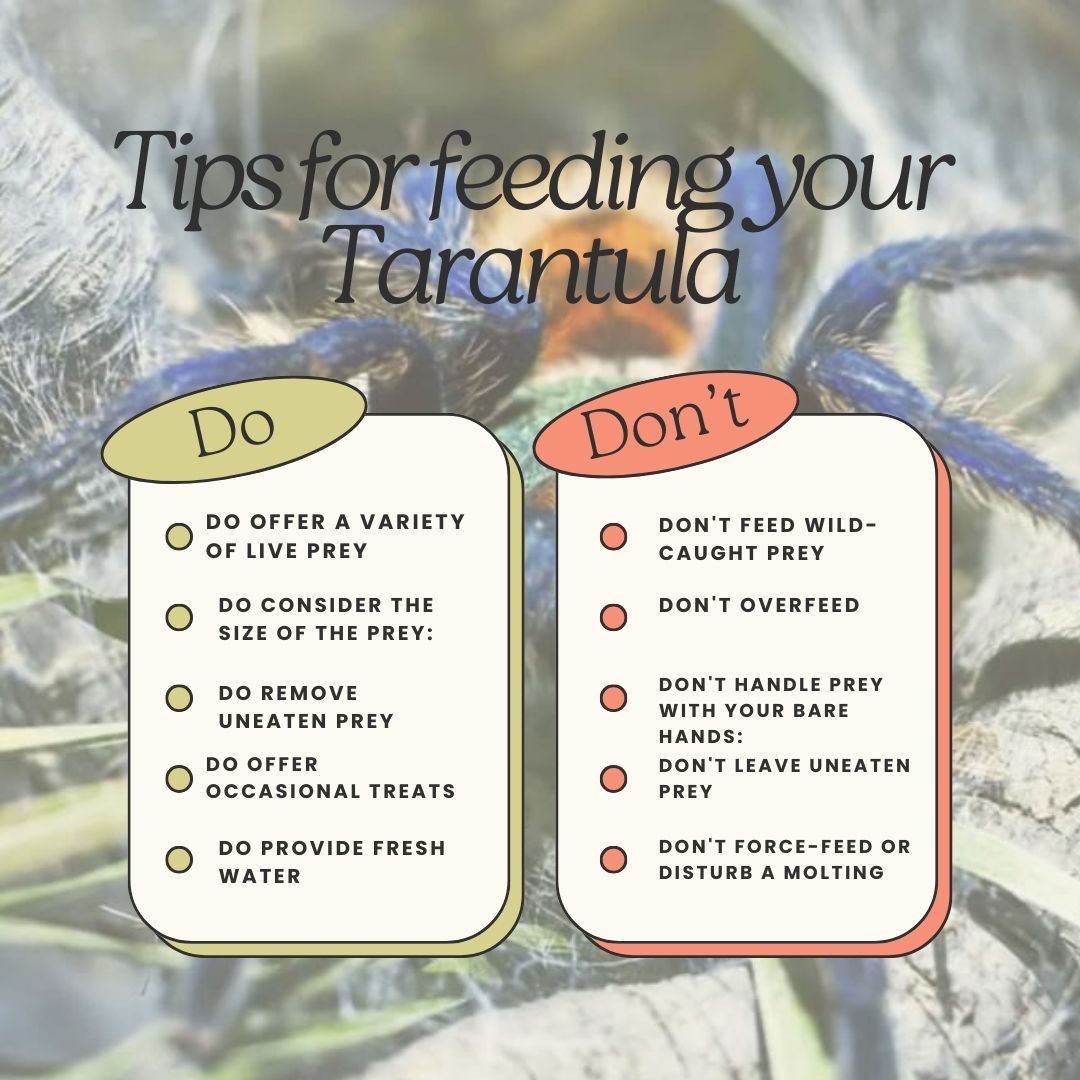The diet of a tarantula plays a vital role in keeping your eight-legged friend in perfect health.
Tarantulas are nocturnal hunters and keep themselves healthy by consuming a nutritious diet consisting of live prey, reflecting their predatory nature. The type of diet, feeding frequency and amount to be fed primarily depends upon many factors such as particular species, and age.
In the wild, tarantulas feed on a variety of insects such as crickets, grasshoppers, beetles, and cockroaches. They may also consume small arthropods like centipedes and millipedes.
Larger species have been known to capture small vertebrates like lizards and frogs.
Moreover, some species such as Brazillian Salmon Pink Bird Eating Tarantula supplement their diet with plant matter such as fruits, leaves, and sugar.
In captivity, tarantulas are commonly fed a diet of live crickets, roaches, mealworms, and occasional treats like waxworms.
Providing a varied diet ensures that tarantulas receive essential nutrients such as protein, fats, vitamins, and minerals necessary for their growth and well-being.
Tarantula Diet in Captivity: What to Feed?
In captivity, their diet consists mainly of live prey items, mimicking their natural feeding habits.
Tarantulas are nocturnal hunters and enjoy it when live feed is served to them. However, if spiderlings are served live prey, it can put your tarantula under stress.
Prey Selection For Diet Of Your Tarantula
Tarantulas primarily consume live prey, and the nutritional value of their diet depends on the type of prey they consume. However ,the slings and growing tarantulas should be given pre-killed prey. Here’s a general overview of the nutritional content of common prey items which you can easily feed your tarantula. To Keep your live feed easily available, these can be separately raised.
Crickets
Crickets are a staple food for many tarantulas which have 55-70% of protein. Crickets are one of the complete foods for your tarantula as they are high in many other nutrients, including fat, calcium, potassium, zinc, magnesium, copper, folate, biotin, pantothenic acid, and iron. Vita-Bugs crickets have high nutritional content and are enhanced with vitamin E, vitamin A, beta-carotene, omega-6, and omega-3 fatty acids.

Dubia Roaches
Roaches, such as Dubia roaches, are another common prey item. They are high in protein, low in fat, and provide essential nutrients like calcium and phosphorus. Roaches provide nearly 8% protein, 21% fiber, and 12% moisture to your tarantula.

Hornworms
Hornworms are rich in protein (9%), and fat(3.07%) and contain essential vitamins and minerals like vitamin B complex, calcium, and potassium.
They provide a nutrient-dense option with nearly good moisture content required for the tarantula.

Flightless Fruit Flies
Flightless fruit flies are a beneficial dietary supplement for tarantulas, providing essential protein(19.7%), fat(13.8%), fiber (3.4%), and nutrients vital for their growth and maintenance. They offer a convenient and enriching food option, supporting the overall health and well-being of these fascinating arachnids.

Other Insects
Tarantulas may also consume a variety of other insects, such as grasshoppers, beetles, larvae, and moths. These insects offer varying levels of protein, fat, and other nutrients depending on their species and diet.

Feeding Time – When to Feed?
Since tarantulas are most active and prone to hunt throughout the evening or night, this is generally the best time to feed them.
Offering food to tarantulas during their natural activity time enhances the likelihood that they will eat, as they are nocturnal creatures.
You may also more easily watch their feeding behavior if you feed them in the evening or at night. Nonetheless, certain tarantulas might continue to feed during the day if they are truly hungry, so it’s critical to keep an eye on their behavior and modify feeding schedules following personal tastes and routines.
Feeding Frequency – How Much to Feed?
The tarantulas have a slow metabolism and hence they do not need to eat very often. But all tarantulas do not require same amount of food. For instance , Goliath Bird Eater tarantulas are voracious eaters and eat nearly twice to any other adult tarantula, say the Chilean Rose.
Diet of an Adult Tarantula
The adult tarantulas typically require feeding once a week to once every two weeks. For example, Curly Hair Tarantula requires about 5-6 large crickets every 2-3 weeks.
Diet of Juvenile Tarantula
The juveniles may need to be fed more frequently, sometimes every few days due to their better metabolism and growth rate. For example, 3-4 medium sized pre-killed crickets can be given to young Curly Hair Tarantula.
Diet of Spiderlings
The spiderlings require meagre quantity of food but with greater frequency. For example beetle larvae,1-2 pre-killed small crickets, pre-killed nymph roaches or a few flightless fruit flies can be given to spiderlings of Curly Hair tarantula.
However, the feeding frequency and amount of feed varies according to the species, age, and size of the tarantula.
Feeding Techniques – How To Feed?
Adult tarantulas prefer to hunt and live prey keeps up their hunting instincts. However, the slings and juveniles need to be given a pre killed food only.
The prey should be dropped with the help of forceps or tongs near the sling or juveniles so that it can be consumed promptly. The long tongs help to maintain better control over the feed and it can be dropped easily at the desired location.
Moreover, it prevents any transfer of bacteria or other contaminants to the tarantula. It also prevents us from accidental bites or urticating hairs, if the tarantula is in aggressive mode.
Water Intake – Does My Tarantula Need Water?
Tarantulas obtain water from their prey and by drinking from shallow water dishes. It’s important to provide clean, chlorine-free water at all times. A shallow dish should be refilled with water regularly as it helps regulate the humidity levels inside the enclosure. I keep the water dish away from the edges, it prevents the tarantula from being injured due to accidental falls from the sides.
Other Important Points to Improve the Diet of Your Tarantula
To ensure the optimum growth of my tarantula, I follow some practices which are
Gut Loading
Sometimes the diet of the tarantula needs to be supplemented with an adequate amount of nutrients that are missing in its commercialized purchased prey. For example, crickets that are purchased from a local pet store are undernourished and lack the required nutrients. Therefore the crickets are gut-loaded before being served to tarantulas which means crickets are first fed with a nutritious diet for nearly 48 hours to revive better health and then these are ready to be served to your tarantula.
This process helps to enhance the nutritional value of the prey and ensures optimal health for these fascinating arachnids.
The nutritional value of the prey can be enhanced through gut loading, where the prey is fed a nutritious diet before being offered to the tarantula. This ensures that the tarantula receives optimal levels of vitamins and minerals from its food.
Changes Required In the Diet Of Tarantula
Tarantula diets may change throughout their life stages, with spiderlings requiring smaller prey items compared to adults. So I try to give a variety of food to be given to my tarantula.
Moreover, if my tarantula refuses to eat or becomes a picky eater, offering different prey items or adjusting feeding techniques helps stimulate its appetite.
Supplementation
Tarantulas usually do not require additional supplementation if they are fed a varied diet of gut-loaded prey. However, if there are signs of deficiency, a vet may recommend supplements such as calcium powder.
Observe Response to Feeding
Tarantulas exhibit various feeding behaviors, including ambush hunting, where they lie in wait for prey to pass by, or active pursuit of prey items.
Observing a tarantula’s feeding behavior can provide insights into its overall health. A sudden change in appetite or refusal to eat may indicate underlying health issues. If your tarantula is preparing to molt or molting, you should not feed it.
Therefore you should try to interpret any significant change in the response to the feed given to your tarantula.
Consulting a Vet – Monitoring Health Through Diet
If there are concerns about a tarantula’s diet or health, you should consult with an exotic pet veterinarian. It is recommended for proper guidance and treatment in time rather than delaying unnecessary.
Overfeeding and Obesity
Overfeeding can lead to obesity and other health issues in tarantulas. The metabolic rate of tarantula is slow so It’s crucial to monitor portion sizes so you should avoid offering prey too frequently.

Removal of uneaten prey
If there is uneaten prey in their enclosure, tarantulas may get stressed or agitated. Moreover, residual food leads to contamination and the growth of harmful bacteria, fungi, or molds.
These contaminants can pose a risk to the health of the tarantula, potentially causing digestive issues or infections.
A clean habitat lowers the possibility of health issues and enhances the tarantula’s general well-being.
Do’s and Don’ts Of Proper Feeding

Feeding a tarantula requires attention to detail to ensure their health and well-being. Here are five do’s and don’ts for feeding a tarantula
Do’s
- Do offer a variety of live prey: Tarantulas thrive on a diet of live insects such as crickets, roaches, mealworms, and waxworms. Providing variety ensures they receive adequate nutrition.
- Do consider the size of the prey: Choose prey that is appropriate in size for your tarantula. Too large of prey can stress or injure the tarantula, while prey that is too small may not provide enough nutrition.
- Do remove uneaten prey: If the tarantula does not consume the prey within a reasonable amount of time (usually within 24 hours), remove it from the enclosure to prevent it from causing stress or harm to the tarantula.
- Do offer occasional treats: Consider adding occasional treats such as small crickets or mealworms dusted with a calcium supplement to provide additional nutrients.
- Do provide fresh water: Ensure your tarantula always has access to fresh, clean water. Use a shallow dish or water gel crystals to prevent drowning.
Don’ts
- Don’t feed wild-caught prey: Wild-caught insects may carry parasites or pesticides that can harm your tarantula. Always purchase prey from a reputable source or breed your own.
- Don’t overfeed: Avoid feeding your tarantula too frequently, as overfeeding can lead to obesity and health problems. Follow a feeding schedule appropriate for the species and age of your tarantula.
- Don’t handle prey with your bare hands: Use feeding tongs or tweezers to handle live prey to prevent accidentally injuring your tarantula or transferring harmful substances from your hands to the prey.
- Don’t leave uneaten prey in the enclosure for too long: Rotting prey can attract pests and promote the growth of harmful bacteria and fungi, posing a risk to your tarantula’s health.
- Don’t force-feed or disturb a molting tarantula: Avoid feeding it during the molting process, as they will not eat and may be vulnerable to injury. Additionally, refrain from disturbing a tarantula during this time, as it can be stressful and disrupt the molting process.
Providing a varied diet of nutritionally balanced prey and occasionally supplementing with gut-loaded prey ensures that tarantulas receive the essential nutrients they need to thrive in captivity.
By considering these points you can gain a comprehensive understanding of tarantula dietary needs and how to ensure your pet’s nutritional health in captivity.


